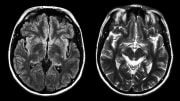
A new study in Rheumatology Advances in Practice reveals that Granulomatosis With Polyangiitis (GPA), a rare nasal disease causing blood vessel inflammation, may be frequently misdiagnosed as a result of nasal damage from cocaine use. Cocaine can induce the production of antibodies that mimic idiopathic GPA, making diagnosis difficult. The researchers conducted a retrospective review of patients at vasculitis clinics, finding that 86% had positive urine toxicology results for cocaine use. They recommend testing for cocaine in patients with destructive nasal lesions or isolated sino-nasal disease before diagnosing GPA, as immunosuppressive drugs may be ineffective and even harmful for ongoing cocaine users.
Researchers found that Granulomatosis With Polyangiitis, a rare nasal disease, may be frequently misdiagnosed due to nasal damage from cocaine use. They recommend testing for cocaine before diagnosing GPA, as common treatments may be ineffective and harmful for cocaine users.
A new paper in Rheumatology Advances in Practice, published by Oxford University Press, indicates that Granulomatosis With Polyangiitis, a nasal disease that causes inflammation of the blood vessels and commonly presents with symptoms in sinuses, throat, lungs, and kidneys, may be commonly misdiagnosed. Researchers believe that many patients identified with the sinus and nasal limited form of the disease may actually be suffering from nasal damage due to cocaine usage.
Cocaine is the second most commonly abused drug in the United Kingdom with 2.6% of the population between ages 16 and 59 years old using it. Some 4.8 million people in the United States (or 1.7% of those over age 12) report using cocaine in the past year. Cocaine can cause significant health problems, including cocaine-induced midline destructive lesions and various other vascular problems. However, evidence shows that cocaine use can trigger the production of certain antibodies that can lead to a clinical presentation that closely resembles idiopathic Granulomatosis With Polyangiitis (GPA-formerly known as Wegener’s granulomatosis).
Together with occasional general symptoms such as arthralgia, fatigue, and skin rash, the similarity between GPA and damage due to cocaine makes diagnosis difficult for physicians. While GPA is rare, affecting approximately 3 out of every 100,000 people, the researchers here believe that the possibility for misdiagnosis is serious, as the common treatments for GPA may be ineffective, and even dangerous, for ongoing cocaine users.
Researchers here performed a retrospective review of patients who visited vasculitis clinics for treatment at Queen Elizabeth Hospital, in Birmingham, and at the Royal Free Hospital, in London. They identified 42 patients and found that current cocaine use was common, some 86% of samples provided were positive when routine urine toxicology was performed; 9 patients who denied ever using cocaine were identified as using cocaine based on urine toxicology analysis, while 11 who stated they were ex-users still tested positive.
The investigators note that ten patients referred to vasculitis treatment centers had been previously given a diagnosis of GPA and given immunosuppressive drugs, and despite this treatment they still had ongoing nasal problems.
The researchers here believe that doctors should test patients with destructive nasal lesions or isolated sino-nasal disease for cocaine before making a diagnosis of GPA. Immunosuppressive drugs, they note, are often ineffective if cocaine use persists and would also increase the risk of significant adverse effects including infection.
“This is an important paper that has changed our practice,” said Aine Burns, one of the paper’s authors. “We now include urine samples for drugs of abuse in our initial investigations of patients with GPA and in those who appear not to be responding to treatment. Sadly, we have seen young people with life-changing disfigurement because of cocaine-induced granulomatosis with polyangiitis. A better understanding of this condition prevents us from potentially harming patients further by administering inappropriate, potentially toxic, and futile treatments. There needs to be heightened awareness of this complication of cocaine use amongst users, the public, and healthcare professionals.”
Reference: “Cocaine-induced granulomatosis with polyangiitis—an under-recognized condition” by Charn Gill, Joseph Sturman, Leyla Ozbek, Scott R Henderson, Aine Burns, Sally Hamour, Ruth J Pepper, Lisha McClelland, Dimitrios Chanouzas, Simon Gane, Alan D Salama and Lorraine Harper, 4 April 2023, Rheumatology Advances in Practice.
DOI: 10.1093/rap/rkad027









Be the first to comment on "Cocaine’s Hidden Dangers: Misdiagnosing Nasal Destruction as a Rare Disease"